外研版必修第三册Unit 4 Amazing Art Period 2 Using languages(Grammar & Vocabulary& Listening课件(共19张PPT)
文档属性
| 名称 | 外研版必修第三册Unit 4 Amazing Art Period 2 Using languages(Grammar & Vocabulary& Listening课件(共19张PPT) | 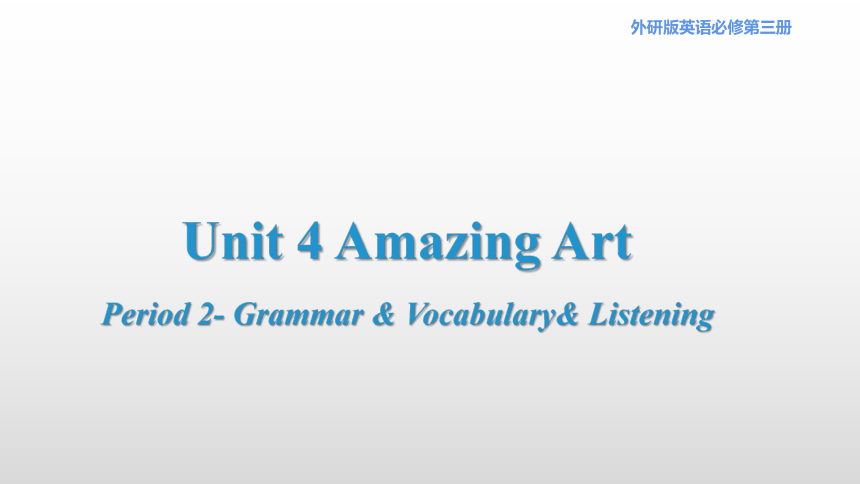 | |
| 格式 | zip | ||
| 文件大小 | 5.8MB | ||
| 资源类型 | 教案 | ||
| 版本资源 | 外研版(2019) | ||
| 科目 | 英语 | ||
| 更新时间 | 2020-04-24 09:25:15 | ||
图片预览

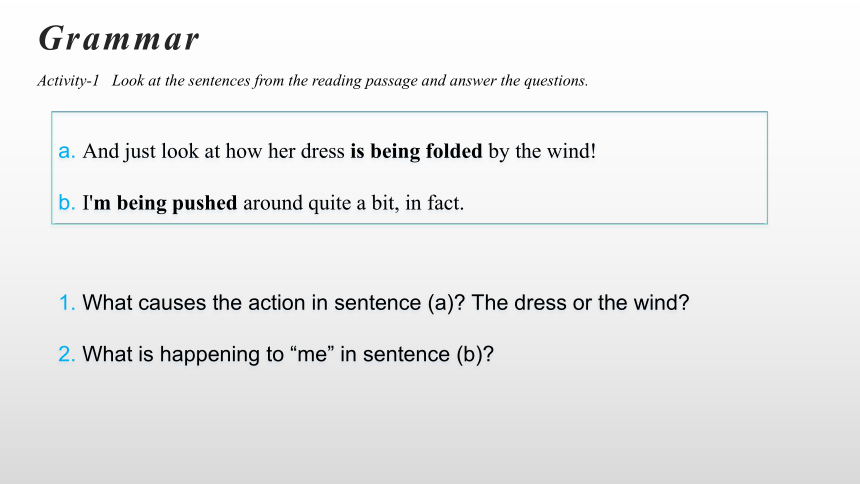


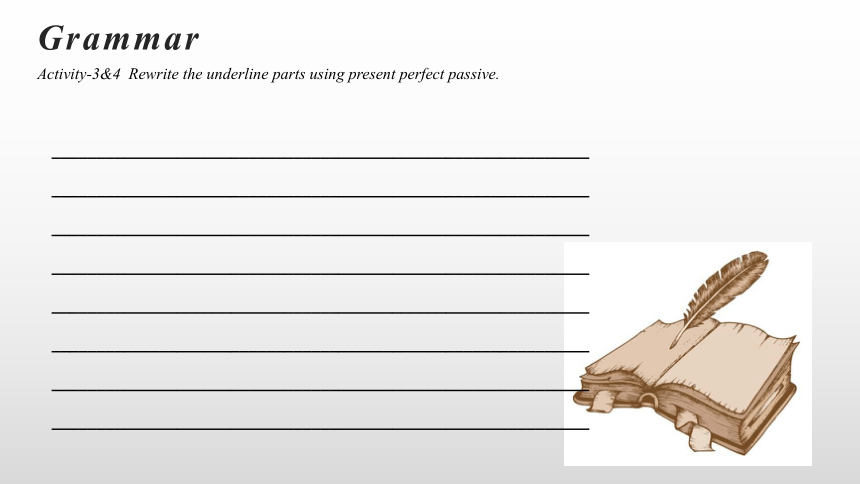
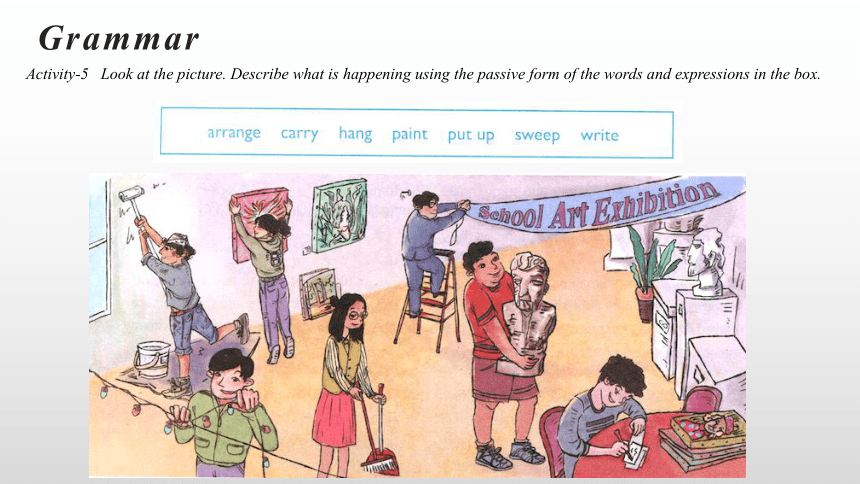
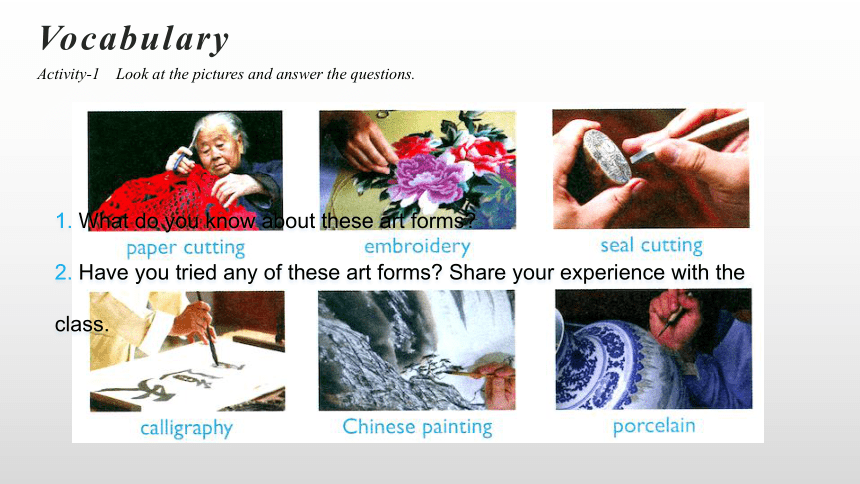
文档简介
课件19张PPT。外研版英语必修第三册 Unit 4 Amazing Art
Period 2- Grammar & Vocabulary& ListeningGrammarActivity-1 Look at the sentences from the reading passage and answer the questions.a. And just look at how her dress is being folded by the wind!
b. I'm being pushed around quite a bit, in fact.1. What causes the action in sentence (a)? The dress or the wind?
2. What is happening to “me” in sentence (b)? GrammarActivity-2 Compare them with the following sentences and answer the questions.c. And just look at how the wind is folding her dress!
d. People are pushing me around quite a bit, in fact.3. What is the difference between the two groups of sentences?
4. Why does the author choose to use the passive form instead of the active form in the reading passage? GrammarActivity-3&4 Now look for more sentences with present continuous passive in the reading passage and rewrite the underline parts using the passive.GrammarActivity-3&4 Rewrite the underline parts using present perfect passive.____________________________________________________________
____________________________________________________________
____________________________________________________________
____________________________________________________________
____________________________________________________________
____________________________________________________________
____________________________________________________________
____________________________________________________________
GrammarActivity-5 Look at the picture. Describe what is happening using the passive form of the words and expressions in the box.VocabularyActivity-1 Look at the pictures and answer the questions. 1. What do you know about these art forms?
2. Have you tried any of these art forms? Share your experience with the class.VocabularyActivity-2 Complete the passage with the words and expressions in last activity.VocabularyActivity-2 Complete the passage with the words and expressions in last activity.ListeningPre-listening :Read “Did You Know” and learn more information about contemporary art.ListeningPre-listening : Look at the “Learning to learn” and get some skills.ListeningWhile-listening: Listen to the conversation and choose the main idea.1. Everyone can create art, whatever their background.
2. We can use art to learn about the world.
3. Art means different things to different people.
4. Everyone should try to include art in their lives.ListeningDeep-listening:
Listen again and complete the table.
Talk about how Jill and Andrew express their opinions towards contemporary artworks. Listen again if necessary.ListeningDeep-listening:
Listen again and complete the table.
Talk about how Jill and Andrew express their opinions towards contemporary artworks. Listen again if necessary.ListeningDeep-listening:
Listen again and complete the table.
Talk about how Jill and Andrew express their opinions towards contemporary artworks. Listen again if necessary.ListeningPost-listening
Work in pairs. Act out the conversation to share your opinions about the artwork.
Work in pairs. Think of another artwork and have a similar conversation.Language Points1. There were different stands where artists could demonstrate their skills and teach the visitors!
[句式分析] 本句包含一个由关系副词where引导的定语从句,先行词是stand,根据上下文,此处译成“展位”更合适。
[尝试翻译] 在不同的的展位前,艺术家可以展示绝活,还可以教游客(如何做)!Language Points2.What caught my attention first was a 15th-century qinghua bowl in a breathtaking exhibition of Chinese porcelain.
[句式分析] 本句的主语是一个主语从句,从句中缺少主语,故用what引导;此外,词组“catch one’s attention”译为“引起某人的注意”。
[尝试翻译] 在令人惊叹的中国瓷器展位中,第一个让我注意到的是一个15世纪的青花碗。 Homework- Review new words and phrases learned in this period.
- Surf the Internet to find more expressions about Chinese traditional artworks.
Period 2- Grammar & Vocabulary& ListeningGrammarActivity-1 Look at the sentences from the reading passage and answer the questions.a. And just look at how her dress is being folded by the wind!
b. I'm being pushed around quite a bit, in fact.1. What causes the action in sentence (a)? The dress or the wind?
2. What is happening to “me” in sentence (b)? GrammarActivity-2 Compare them with the following sentences and answer the questions.c. And just look at how the wind is folding her dress!
d. People are pushing me around quite a bit, in fact.3. What is the difference between the two groups of sentences?
4. Why does the author choose to use the passive form instead of the active form in the reading passage? GrammarActivity-3&4 Now look for more sentences with present continuous passive in the reading passage and rewrite the underline parts using the passive.GrammarActivity-3&4 Rewrite the underline parts using present perfect passive.____________________________________________________________
____________________________________________________________
____________________________________________________________
____________________________________________________________
____________________________________________________________
____________________________________________________________
____________________________________________________________
____________________________________________________________
GrammarActivity-5 Look at the picture. Describe what is happening using the passive form of the words and expressions in the box.VocabularyActivity-1 Look at the pictures and answer the questions. 1. What do you know about these art forms?
2. Have you tried any of these art forms? Share your experience with the class.VocabularyActivity-2 Complete the passage with the words and expressions in last activity.VocabularyActivity-2 Complete the passage with the words and expressions in last activity.ListeningPre-listening :Read “Did You Know” and learn more information about contemporary art.ListeningPre-listening : Look at the “Learning to learn” and get some skills.ListeningWhile-listening: Listen to the conversation and choose the main idea.1. Everyone can create art, whatever their background.
2. We can use art to learn about the world.
3. Art means different things to different people.
4. Everyone should try to include art in their lives.ListeningDeep-listening:
Listen again and complete the table.
Talk about how Jill and Andrew express their opinions towards contemporary artworks. Listen again if necessary.ListeningDeep-listening:
Listen again and complete the table.
Talk about how Jill and Andrew express their opinions towards contemporary artworks. Listen again if necessary.ListeningDeep-listening:
Listen again and complete the table.
Talk about how Jill and Andrew express their opinions towards contemporary artworks. Listen again if necessary.ListeningPost-listening
Work in pairs. Act out the conversation to share your opinions about the artwork.
Work in pairs. Think of another artwork and have a similar conversation.Language Points1. There were different stands where artists could demonstrate their skills and teach the visitors!
[句式分析] 本句包含一个由关系副词where引导的定语从句,先行词是stand,根据上下文,此处译成“展位”更合适。
[尝试翻译] 在不同的的展位前,艺术家可以展示绝活,还可以教游客(如何做)!Language Points2.What caught my attention first was a 15th-century qinghua bowl in a breathtaking exhibition of Chinese porcelain.
[句式分析] 本句的主语是一个主语从句,从句中缺少主语,故用what引导;此外,词组“catch one’s attention”译为“引起某人的注意”。
[尝试翻译] 在令人惊叹的中国瓷器展位中,第一个让我注意到的是一个15世纪的青花碗。 Homework- Review new words and phrases learned in this period.
- Surf the Internet to find more expressions about Chinese traditional artworks.
